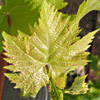Vitis vinifera (Grapevine) is a perennial winter-deciduous climber. It may reach a height of 20 meters, according to the tree on which it climbs. It sprouts in the spring and grows new branches. The branches carry racemose inflorescences. The Grapevine blooms in a panicle rich with tiny flowers. The axis of the inflorescences branches from the branch, and is situated opposite the leaf, similarly to the tendril. The flower has a double perianth: 5 calyx lobes and 5 green petals. The petals are usually fused at their tip, and are shed as a single unit. When the corolla sheds, the stamens and the pistil are exposed, and pollination takes place, both by wind and by insects that are attracted to the scent of the flowers and to the nectar.
The Grapevine is grown agriculturally in all regions of Israel. It originates in the Middle East, and it is possible that some of the grapevines that grow in Israel are wild plants. Grapevine cultivation is among the most important agricultural crops in the world. The annual global yield is 70 million tons of grapes. In Israel the annual yield is 100,000 tons. The greatest annual grape yield in 2008 was in Italy, followed (in descending order) by China, the United States, Spain, France, Turkey, Argentina, Chile, Australia, South Africa, Iran, India and Egypt. Most of the grapevines are grown for wine production. In countries such as France, Italy and Spain, the annual wine consumption per person reaches up to 100 liters. In Israel, the main use for grapes is for eating, and recently also more for wine production, and some for the production of raisins, vinegar and grape juice.
The grape is one of the seven kinds with which the Land of Israel was blessed, and is mentioned in the Bible and in the ancient literature of all countries of the Middle and Far East, as well as in Greece and Rome. Paintings of the grapevine were found in ancient mosaics and manuscripts of all peoples (including warnings against overuse of wine). This is one of the oldest domesticated and edible plants. There is evidence for growing of grapevines from 6000 years ago. It was apparently developed from the wild grapevine in north-east Turkey. Over the generations, the grape became common in many countries as an edible fresh fruit, for drying as raisins and for squeezing the juice for the production of wine and vinegar. It was common already during antiquity for ritual uses, for decoration and for architecture, in paintings, reliefs and mosaics.
There are many varieties: edible grapes, wine grapes, red varieties, white varieties, varieties with and without seeds. The edible grape can grow in warm and dry regions. Grape for wine is grown in cool regions. The grapevine is also used for ornamentation and for shade for covering sheds in which farmers sleep in the summer, and for pergolas in Mediterranean gardening.
Written by Udi Michalis






